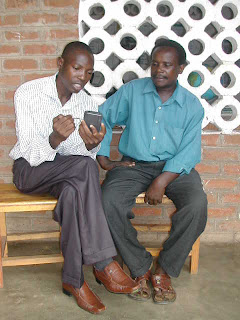
After the form was deemed designed, I taught the team how to load (also known as "synchronize") the form onto each of the PDA's that we would use for testing. Then, I had each PDA holder to conduct several interviews with other team members. We then synchronized the collected data back to the form designer and it looked all good. We were ready.
We took two vehicles and split the team in two and each group headed to a different school. The group that I went with arrived at the Nasite elementary school but a few kilometers south of Mangochi. I love this part. We first presented ourselves to the head teacher and it was explained why we were there, and what the purpose of our trip was.

While the team split up to interview teachers in their classes, I took a moment to enter a large classroom next door. A young teacher was seated at a table in the far corner of this room with a dirt floor interspersed with broken concrete and no lighting. He had several students at his desk as he was writing in a register. I asked him how many students that he had in his classroom each day, and he said that it averaged about 198.

As I walked out side his classroom preparing to follow and observe a PDA team member, I noted a group of children under a large tree trying to avoid the rain. The next series of pictures were taken within an interval of perhaps 5 seconds between them and within a total of less than 30 seconds:

2nd

3rd

The interviews went smoothly and we soon departed to meet up with the 2nd team at the Kausi school nearby. I will never forget riding up to the school site in the back seat and Amy Richmond in the front. Both of us are quite light-skinned. The chanting that we heard as we drove up across the compound was from the children racing across the yard saying, "The Whites are here, the whites are here!" As we were introduced to the head teacher (in a stunning bright blue suit), I noted several older students using small wispy branches to literally whisk the students back to their classrooms. I thought to myself, I wish I could of had that job back at my small elementary school in the 1960's suburbs of Southern California.
I was observing one of the team members interviewing a teacher with his PDA just outside the classroom. I emphasize the need to observe a respondents visual cues in order ot assess their willingness to be interviewed with technology, and to be alert on when there is a need to employ ones' developed set of interviewer skills to enjoin trust in order to have a successful, unbiased interview (if that is possible).

In the first picture above, the respondent is displaying body language of hesitation towards the interviewer and the PDA. Note the hands on the hips, and the leaning away from the interviewer.

In the second picture the interviewer has wisely turned the PDA screen towards the teacher, who has now begun to lean towards the interviewer and has begun demonstrating curiosity towards the interview collection instrument. Hold on, we're not there yet!

Now, the interviewer has gained the respondents trust and curiosity has been disregarded for the moment. note how the body language of the teacher has changed and now the PDA is disregarded and the teacher is instead thoughtfully considering his answers to the interviewers questions.
Please note, that with a PDA, an interviewer is not able to hold up the classic large clipboard and paper survey form which can often act as a barrier, both physically and communicatively between the two persons. A PDA is different and actually can be leveraged to enjoin trust.

No comments:
Post a Comment